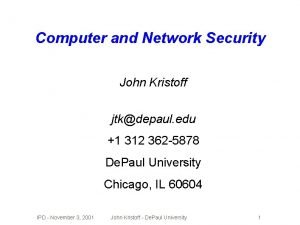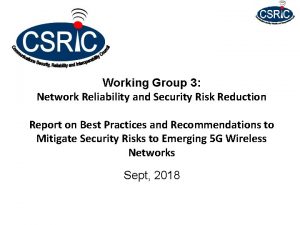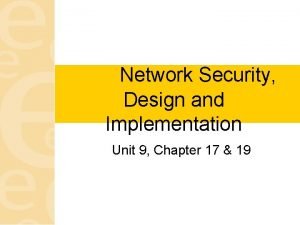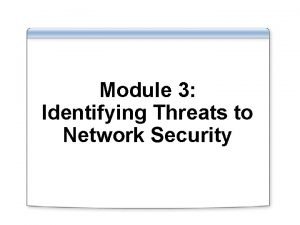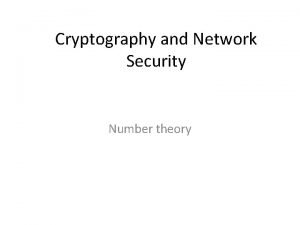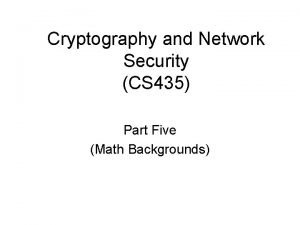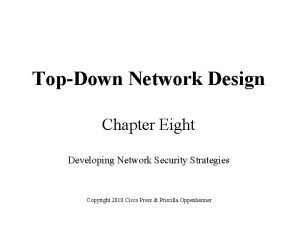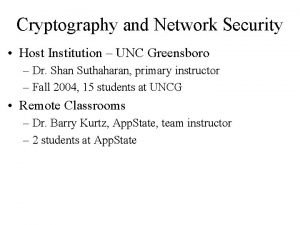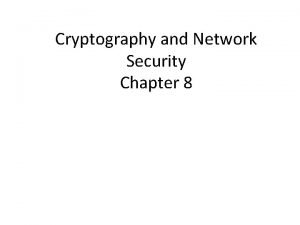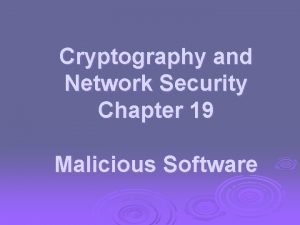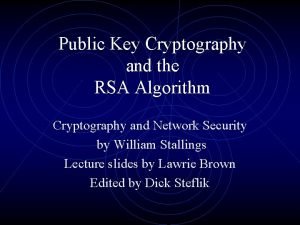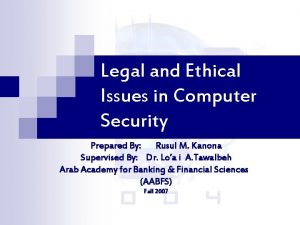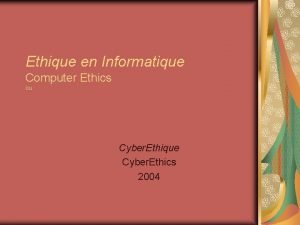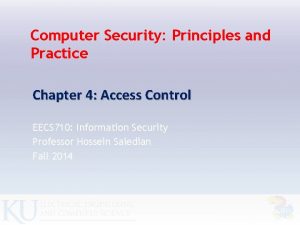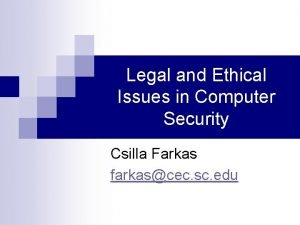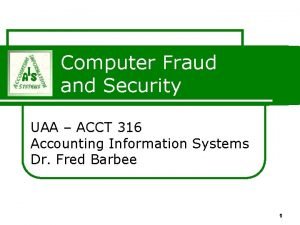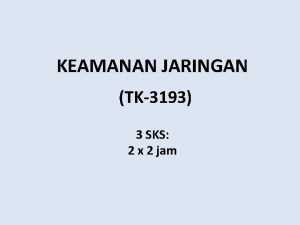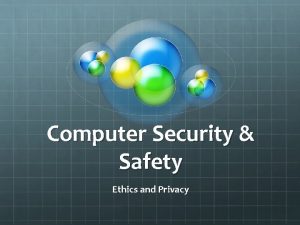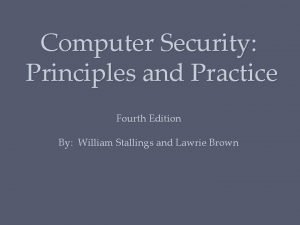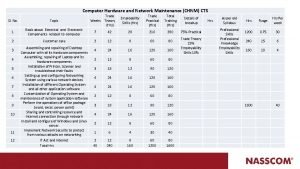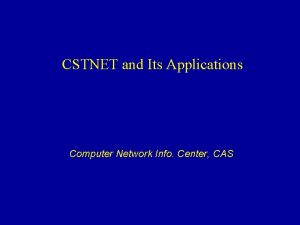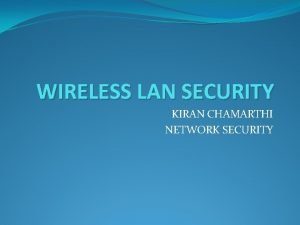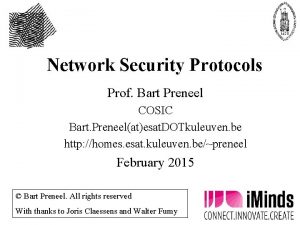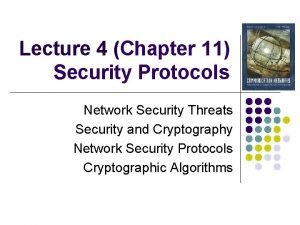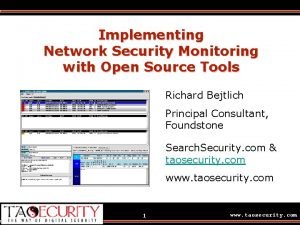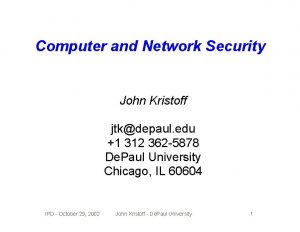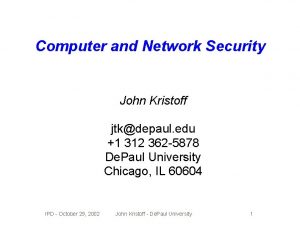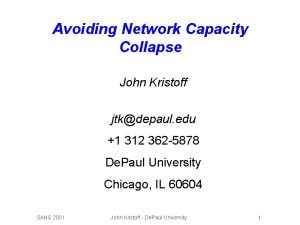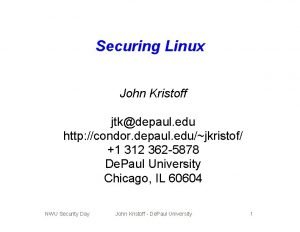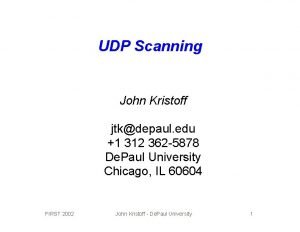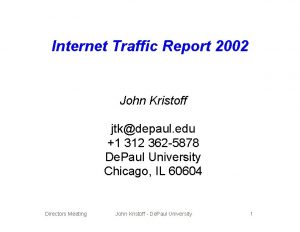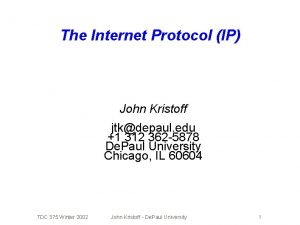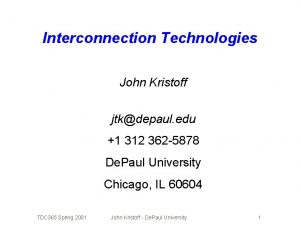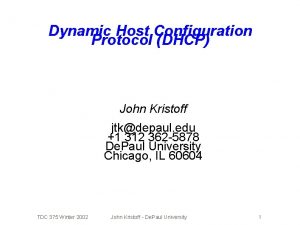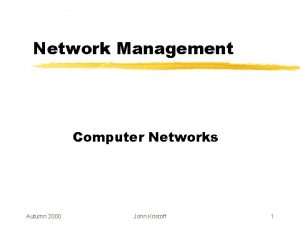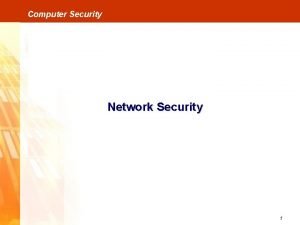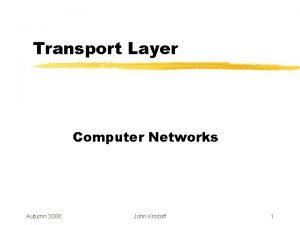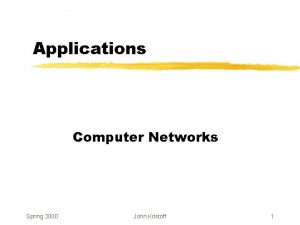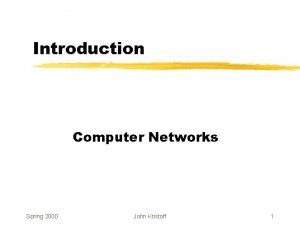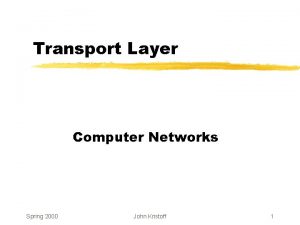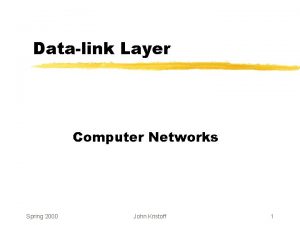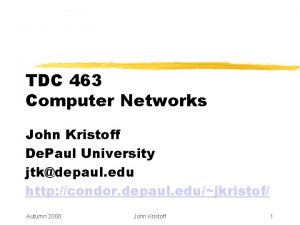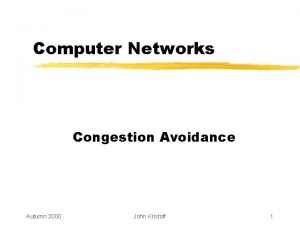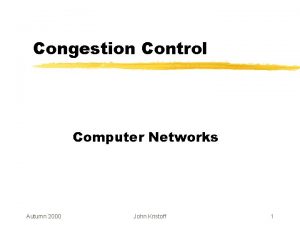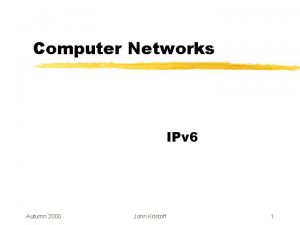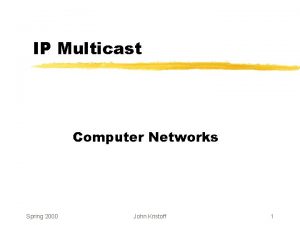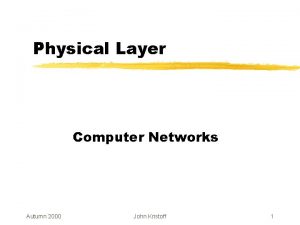Computer and Network Security John Kristoff jtkdepaul edu


































































- Slides: 66

Computer and Network Security John Kristoff jtk@depaul. edu +1 312 362 -5878 De. Paul University Chicago, IL 60604 IPD - November 3, 2001 John Kristoff - De. Paul University 1

What are you trying to secure? � Confidentiality � Avoid � Authentication snooping � Encryption? that you? � Nonrepudiation � Integrity � No � Deletes, changes � Backups � Access control off! � Reputation attacks IPD - November 3, 2001 denying it � Hands � Availability � (D)Do. S � Is � Name John Kristoff - De. Paul University = MUD 2

Internet security really bites � LOTS � Bad of hosts are hard to secure default configurations � Poor software implementations � Fixes/patches � Average � It rarely applied user/admin is security clueless is difficult to coordinate among sites � Any weak link can break the security chain IPD - November 3, 2001 John Kristoff - De. Paul University 3

Why doesn't telco security bite? Telco Internet � Central authority � Network � Billing intelligence records per call � Legalese understood � Wiretapping � Circuit laws connections IPD - November 3, 2001 � No central authority � End � No host intelligence packet accounting � Legalese � Privacy � Ease John Kristoff - De. Paul University fuzzy issues of anonymity 4

So where do you put security? IPD - November 3, 2001 John Kristoff - De. Paul University 5

Physical security � Trash bins � Social engineering � It's easier to trust a face/voice than a packet � Protect from the whoops! � Don't trip over the power cord � Don't spill your coffee � Hit the right switch � Software really can kill hardware IPD - November 3, 2001 John Kristoff - De. Paul University 6

End host security � The end-to-end argument � This is usually where the problem is � But, ultimately you want to protect data � End hosts are in control of data � Users are in control of hosts � Users often don't secure hosts sufficiently � There are LOT of hosts and LOTS of users IPD - November 3, 2001 John Kristoff - De. Paul University 7

Network security � Inspect � Boy, and act on packets as they go this is really hard! � Evasive tactics like tunneling get through � Uh-oh. . . encryption � What � Can � This am I breaking? I relay, inspect and act fast enough? might help, but its not a panacea IPD - November 3, 2001 John Kristoff - De. Paul University 8

Probably need layered defenses � The belt and suspenders approach � Attackers � Multiple � Use � If might hit a layer they can't break layers tend to slow attacks down the laws of statistics defense A stops 90% of all attacks, � And if defense B stops 90% of all attacks, � Then combined they may stop 99% of all attacks �(1 -. 9)*(1 -. 9) IPD - November 3, 2001 =. 01, 1 -. 01 =. 99 or 99% John Kristoff - De. Paul University 9

The network is just a highway � How do you secure the highway � Police � Toll patrol booths � Licensed � Vehicle � Rules � Are drivers inspections and standards of the road the highways completely safe now? IPD - November 3, 2001 John Kristoff - De. Paul University 10

Perimeter security " Separate trusted net from untrusted net " Define the boundary IPD - November 3, 2001 John Kristoff - De. Paul University 11

What network firewalls do � Define untrusted and trusted boundaries � Inspect traffic traversing firewall boundary � Limit communication traversing boundary � Help shield insecure hosts IPD - November 3, 2001 John Kristoff - De. Paul University 12

Network firewalls illustrated IPD - November 3, 2001 John Kristoff - De. Paul University 13

Key ideas �Firewalls �They're �They a network solution to a host problem don't solve the real problem and. . . �. . make it hard/impossible to do certain things �Ultimate control of hosts is out of our hands �Securing �But. . should be unnecessary a LOT of hosts is hard! network solutions are *sigh* necessary IPD - November 3, 2001 John Kristoff - De. Paul University 14

Packet filtering firewalls � Filter everything - not very useful � Filter by IP address � Filter by application type (TCP, UDP) � Filter on field/flag settings (source route) � Filter invalid packets (SYN/FIN packets) � Other pattern match IPD - November 3, 2001 John Kristoff - De. Paul University 15

Screened subnet implementation IPD - November 3, 2001 John Kristoff - De. Paul University 16

Application Layer Gateway (ALG) � Also commonly called a proxy firewall � These permit no direct communication � Firewall � Very intercepts all traffic in each direction intelligent device. . . �. . . must understand what a user is doing � Difficult to install if it doesn't currently exist IPD - November 3, 2001 John Kristoff - De. Paul University 17

Proxy/ALG illustrated IPD - November 3, 2001 John Kristoff - De. Paul University 18

Other common firewall features � Stateful inspection � Network address translation (NAT) � Authenticaton � Dynamic (VPNs) triggers � Reporting, logging and IDS support IPD - November 3, 2001 John Kristoff - De. Paul University 19

Example: Linux ipchains Don't want to see packets with private IP addresses -A input -s 192. 168. 0. 0/255. 0. 0 -d 0. 0/0. 0 -j DENY -A input -s 172. 0. 0. 0/255. 240. 0. 0 -d 0. 0/0. 0 -j DENY -A input -s 10. 0/255. 0. 0. 0 -d 0. 0/0. 0 -j DENY Let SSH, established TCP connections, FTP data, UDP and BOOTP/DHCP in -A input -s 0. 0/0. 0 -d a. b. c. d/255. 255 22: 22 -p 6 -j ACCEPT -A input -s 0. 0/0. 0 -d a. b. c. d/255. 255 1024: 65535 -p 6 ! -y -j ACCEPT -A input -s 0. 0/0. 0 20: 20 -d 0. 0/0. 0 1024: 65535 -p 6 -y -j ACCEPT -A input -s 0. 0/0. 0 -d 0. 0/0. 0 1024: 65535 -p 17 -j ACCEPT -A input -s 0. 0/0. 0 -d 0. 0/0. 0 67: 67 -p 17 -j ACCEPT Drop any packets that don't have our source IP and log those attempts -A output -s 140. 192. 0. 1/255. 255 -d 0. 0/0. 0 -j DENY -l IPD - November 3, 2001 John Kristoff - De. Paul University 20

Example: Cisco ACL Block private IP addresses access-list 100 deny ip 192. 168. 0. 0. 255 any access-list 100 deny ip 172. 0. 0. 0 0. 15. 255 any access-list 100 deny ip 10. 0 0. 255 any Block reserved, loopback and Class E IP addresses access-list 100 deny ip 0. 0 0. 255 any access-list 100 deny ip 127. 0. 0. 0 0. 255 any access-list 100 deny ip 224. 0. 0. 0 31. 255 any Block source port of 111 from going anywhere access-list 100 deny tcp any eq sunrpc any access-list 100 deny udp any eq sunrpc any Allow DNS and TELNET (log it) to 1. 2. 3. 4, deny everything else access-list 100 permit tcp any host 1. 2. 3. 4 eq domain access-list 100 permit tcp any host 1. 2. 3. 5 eq telnet log IPD - November 3, 2001 access-list 100 deny ip any. John Kristoff - De. Paul University 21

What can't a network firewall stop? � Bad packets that look good � Denial � Well, � But of service (Do. S) attacks they can stop them at the firewall then the firewall has just been Do. S'd � Stupid user tricks � Things that go around the firewall � Things that don't cross the firewall boundary IPD - November 3, 2001 John Kristoff - De. Paul University 22

So you're saying. . . ? �It would be nice if all hosts could be secured �Network solutions can help �Malicious �A insiders can get by anything you got holistic approach is needed. Including: � Audits, detection and response � Education � Standards IPD - November 3, 2001 and best practices John Kristoff - De. Paul University 23

Intrusion Detection Systems � Interesting, � Provides but immature technology lots of data/information � Generally doesn't interfere with communications � Anything that improves security. . . IPD - November 3, 2001 John Kristoff - De. Paul University 24

What is IDS? � Ideally, immediately identifies successful attacks � Should have a immediate notification system � Out-of-band � Probably from the attack if possible can also monitor attack attempts too � Might have attack diagnosis, recommendation and/or automated attack mitigation response � Lofty goals: � 0% false positive rate � 0% false negative rate IPD - November 3, 2001 John Kristoff - De. Paul University 25

Privacy issues � Does � Are � Is an IDS violate privacy? packet headers (protocols) private? identification (an address) private? � Are packet contents private (payload)? � Are communications (flows/sessions) private? � Where is the IDS? � Who manages the IDS? � How is the IDS data handled and managed? IPD - November 3, 2001 John Kristoff - De. Paul University 26

Storage, mining and presentation � IDSs can collect LOTS of information � What is useful data? � What are you looking for? � Data correlation within/outside of the IDS? � What does the admin see? � Where � How and for how long do you keep data? do you secure access to IDS data? IPD - November 3, 2001 John Kristoff - De. Paul University 27

Host IDS � An integral part of an end-system � System � Kernel log monitor level packet monitor � Application �A specific very good place to put security � Distributed management issues � Not all end systems will support an IDS � Will be as useful as the end user is cluefull IPD - November 3, 2001 John Kristoff - De. Paul University 28

Network IDS � An add-on to the communications system � Generally � May passive and invisible to the ends see things a host IDS cannot easily see � Fragmentation, � May not understand network traffic � Unknown � May other host attacks (correlation) protocols/applications, encryption miss things that don't cross its boundary IPD - November 3, 2001 John Kristoff - De. Paul University 29

Anomaly detection �A form of artificial intelligence � Learn � If what is normal for a network/system an event is not normal, generate alert � May � For catch new attacks not seen before a simple, but effective example see: � Detecting Backdoors, Y. Zhang and V. Paxson, 9 th USENIX Security Symposium � An area of active research IPD - November 3, 2001 John Kristoff - De. Paul University 30

Signature matching � Know what an attack looks like and look for it � Very easy to implement � Low false positive rate � Most current IDSs are of this type � Easy to fool � Signatures IPD - November 3, 2001 must be added/updated regularly John Kristoff - De. Paul University 31

Honeypots �A system that welcomes attacks � Unbeknownst to the attacker generally � The system is very closely monitored � Can be used to test new technology/systems � Generally � Helpful � Be educational in nature as trend monitor for that system type careful honeypot doesn't become liability IPD - November 3, 2001 John Kristoff - De. Paul University 32

Possible IDS failure modes � Fragmentation, � Requires � Inability state and high-speeds lots of CPU, memory and bandwidth to decode message/transaction � t^Hrr^Hm 56^H^H � Background //^H -u^Hrf noise � Tunnelling/encryption � IDS path evasion � Stupid user tricks IPD - November 3, 2001 John Kristoff - De. Paul University 33

The poor man's Network IDS � Setup a router subnet and unix host � Block all outgoing/incoming packets � access-list 100 deny ip any log � Log packets (filter matches) with syslog � Use perl/grep/uniq/. . . to build simple reports � Total violations: 468 � Top source host: badguy. org � Top dest. TCP port: 21 (ftp) IPD - November 3, 2001 John Kristoff - De. Paul University 34

The poor man's host IDS � Use � Turn snort (http: //www. snort. org) or. . . on all logging and do log reporting � Install fake service and monitor � tcp_wrappers, � Use diff (or equivalent), monitor file changes � Keep � Use back officer friendly copies of data/configs elsewhere Tripwire or equivalent IPD - November 3, 2001 John Kristoff - De. Paul University 35

Encryption or Fodszqujpo �Try to make something readable, unreadable �Usually math intensive �Plain text to cipher text to plain text �Need strong algorithms and secure keys � Public � How � Key versus private keys do you exchange keys securely? escrow, recovery and trusted 3 rd parties IPD - November 3, 2001 John Kristoff - De. Paul University 36

Shared secret key �Each �The party knows the secret key decrypts the cipher text � Book = Ulysses � Key = 7, 23, 4 �. . . or page 7, line 23, word 4 �Ulysses �How is the secret key, don't tell anyone! do the trusted parties learn the key? IPD - November 3, 2001 John Kristoff - De. Paul University 37

Shared secret key illustrated IPD - November 3, 2001 John Kristoff - De. Paul University 38

Public key cryptography �Advertise your well known public key � Everyone � Once �Private � Only uses it to encrypt messages to you encrypted, no one can decrypt it key you have the private key � Private �Keyrings key decrypts the public key encryption and secure public key distribution IPD - November 3, 2001 John Kristoff - De. Paul University 39

Public key illustrated IPD - November 3, 2001 John Kristoff - De. Paul University 40

Pretty Good Privacy (PGP) �Crypto �Uses software for mail, files and disks public (and private) key technology �Supports �Public �Free digital signatures key servers maintain public keys for non-commercial use �http: //web. mit. edu/network/pgp. html IPD - November 3, 2001 John Kristoff - De. Paul University 41

Virtual Private Networks (VPNs) �Make �Use an insecure public network secure Internet instead of building your own net �Secure/encrypted �Endpoints �Sound �Many tunnels between endpoints must be secure like a host security problem? Yep. challenges and trade-offs IPD - November 3, 2001 John Kristoff - De. Paul University 42

VPNs illustrated IPD - November 3, 2001 John Kristoff - De. Paul University 43

Potential VPN problem IPD - November 3, 2001 John Kristoff - De. Paul University 44

IP Security (IPSec) �Standardized by IETF �Authentication Header (AH) � Authenticates �Encapsulating � Encrypts �Internet Security Payload (ESP) data before transmission Key Exchange (IKE) � Governs �IPSec sender and packet contents exchange of keys between end hosts is often used in VPNs IPD - November 3, 2001 John Kristoff - De. Paul University 45

Kerberos �Popular for network based authentication �Also for authorization �Also used to encrypt network traffic �Uses the concept of issuing tickets to users �Uses centralized server for management � Must �Been be secure of course! around for awhile, becoming popular IPD - November 3, 2001 John Kristoff - De. Paul University 46

Network Address Translation �Meant �NAT to be a IPv 4 address depletion solution is wrongly applied as a security solution �Deployment �Using �NAT �If �I of NAT has hurt the Internet NAT is expensive breaks many things you have addresses, don't use NAT don't like NAT - can you tell? IPD - November 3, 2001 John Kristoff - De. Paul University 47

NAT illustrated IPD - November 3, 2001 John Kristoff - De. Paul University 48

Enough already, how do we hack? �We'll focus on over the network attacks �Password � Brute cracking force, keystroke capture, sniff �OS/Application � Buffer �Protocol overflows, cgi-bin attacks, email exploits abuses � Spoofs, �Denial attacks hijacks, redirects, man-in-the-middle of service attacks IPD - November 3, 2001 John Kristoff - De. Paul University 49

Anatomy of a typical compromise �Do some reconnaissance work, scan, probe �Launch the exploit �Maintain �Fix compromised access with backdoors system so no one else gets in �Use/abuse �Make system it look like you were never there �Sometimes a few of these steps are skipped IPD - November 3, 2001 John Kristoff - De. Paul University 50

Network scanning/mapping �PING, �DNS traceroute information �rpcinfo -p <hostname> �nmap �nbtstat, net use commands �Search engines, newsgroups, web sites �If you're on the Internet, you've been scanned IPD - November 3, 2001 John Kristoff - De. Paul University 51

Session hijacking �Pretend �Take �You to be someone you're not over or insert commands into a session may need to � Know IP addresses � Predict � Keep � Run TCP sequence numbers one end of the real session busy blind for awhile IPD - November 3, 2001 John Kristoff - De. Paul University 52

Session hijacking illustrated IPD - November 3, 2001 John Kristoff - De. Paul University 53

Password cracking �Encrypted passwords can be broken � If nothing else, by brute force � Don't �Sending let passwords be the only line of defense logins in plain text over net is bad! � Many apps do this (e. g. FTP, TELNET) � Even HTTP! �Things like kerberos, SSL and SSH help a lot IPD - November 3, 2001 John Kristoff - De. Paul University 54

Viruses and worms �Programs whose goal is to spread �. . . and possibly cause you a great deal of grief �Worms are common (e. g. ILOVEYOU) �Viruses infect other programs �Somehow � Proves � Some � e. g. code has to be executed users are too trusting feature-full apps are becoming problems Microsoft getting burned regularly here IPD - November 3, 2001 John Kristoff - De. Paul University 55

Weak input validation �Buffer overflows and format string attacks � strcpy(destvar, �Try �If srcvar) type of stuff to get your overflowed data to execute program was running as root/Admin. . . �. . . and �It's you can successfully overflow a buffer. . . probably game over for said system. �Remote overflows are very possible/popular IPD - November 3, 2001 John Kristoff - De. Paul University 56

Denial of service (Do. S) attacks �Prevents �SYN or impairs standard service flooding �SMURF attacks �Distributed �Source �How �No Do. S attacks address spoofing helps attacker to discern valid data from Do. S packets? perfect solution exists today IPD - November 3, 2001 John Kristoff - De. Paul University 57

Do. S attack illustrated IPD - November 3, 2001 John Kristoff - De. Paul University 58

DDo. S attack illustrated IPD - November 3, 2001 John Kristoff - De. Paul University 59

Partial (D)Do. S solutions �Gotta find the sources - not trivial if spoofed! �Ingress/egress �ICMP traceback (itrace) �Packet �Rate marking (pushback) limiting �Shunning �Work filtering and black hole routing with upstream provider IPD - November 3, 2001 John Kristoff - De. Paul University 60

How do I secure Windows? �echo Y | del c: *. * Just kidding. . . �Keep up to date on patches � Run Windows Update �Remove unnecessary protocols like NETBIOS �Be very wary of running unknown programs �Do not use file/print sharing �Install and use virus protection, security tools IPD - November 3, 2001 John Kristoff - De. Paul University 61

How do I secure UNIX/Linux? �Remove unnecessary services � Empty � Start out inetd. conf if possible removing rc. d scripts and programs �Keep up to date on patches �Avoid RPC, wu-ftpd, BIND, sendmail � And �Use others that continue to have probs security tools IPD - November 3, 2001 John Kristoff - De. Paul University 62

How do I secure network devices? �Remove �Disable �Install �Put unnecessary services directed broadcasts spoofing filters device IP on secured management net �Secure routing protocols �Secure logs, time sync, snmp, etc. �Keep up to date on system software IPD - November 3, 2001 John Kristoff - De. Paul University 63

How do I secure. . . ? �Web servers �FTP servers �Mail (SMTP/POP/IMAP) servers �Printers, webcams, toasters �Others. . . ? IPD - November 3, 2001 John Kristoff - De. Paul University 64

Any last bit of advice? �Use the Network Time Protocol (NTP) �syslog �SSH is your friend �Learn �Find like you've never syslog'd before and make use of perl a good mailing lists/digests/URLs �Know your netstat -an |more output �Please do not attack De. Paul's network IPD - November 3, 2001 John Kristoff - De. Paul University 65

References http: //networks. depaul. edu/security/ http: //condor. depaul. edu/~jkristof/ news: //news. depaul. edu/dpu. security http: //www. cert. org http: //www. sans. org http: //www. cerias. purdue. edu http: //www. neohapsis. com http: //www. securityfocus. com IPD - November 3, 2001 John Kristoff - De. Paul University 66
 Lisa meyers children
Lisa meyers children Wireless security in cryptography
Wireless security in cryptography Private security
Private security Computer and network security
Computer and network security Osi security architecture
Osi security architecture Security guide to network security fundamentals
Security guide to network security fundamentals Electronic mail security in network security
Electronic mail security in network security Security guide to network security fundamentals
Security guide to network security fundamentals Security guide to network security fundamentals
Security guide to network security fundamentals Computer & network security
Computer & network security Network topologies
Network topologies Edu.sharif.edu
Edu.sharif.edu Security policy and integrated security in e-commerce
Security policy and integrated security in e-commerce 5g americas
5g americas Network security design
Network security design Module 3: information and network security
Module 3: information and network security Modulo table
Modulo table Security mechanisms in cryptography
Security mechanisms in cryptography Number theory in cyber security
Number theory in cyber security Firewall base layer
Firewall base layer Authentication in cryptography and network security
Authentication in cryptography and network security Intruders in cryptography
Intruders in cryptography Primitive root of a number in cryptography
Primitive root of a number in cryptography Cryptography and network security 6th edition pdf
Cryptography and network security 6th edition pdf Cryptography and network security pearson
Cryptography and network security pearson Source
Source Cryptography and network security 4th edition
Cryptography and network security 4th edition Euler's theorem in cryptography and network security
Euler's theorem in cryptography and network security Finite fields in cryptography and network security
Finite fields in cryptography and network security Digital signature in cryptography and network security
Digital signature in cryptography and network security Modular arithmetic in cryptography and network security
Modular arithmetic in cryptography and network security Pgp in cryptography and network security
Pgp in cryptography and network security Top-down network design
Top-down network design Network and security greensboro
Network and security greensboro Euler's theorem in cryptography and network security
Euler's theorem in cryptography and network security Malicious software in cryptography
Malicious software in cryptography Introduction to cryptography and network security
Introduction to cryptography and network security Rsa algorithm in cryptography and network security
Rsa algorithm in cryptography and network security Introduction to cryptography and network security
Introduction to cryptography and network security Legal, social, ethical and professional issues in computing
Legal, social, ethical and professional issues in computing Legal and ethical issues in computer security
Legal and ethical issues in computer security Ethique quiz
Ethique quiz Computer security principles and practice
Computer security principles and practice Computer security principles and practice solutions
Computer security principles and practice solutions Legal and ethical issues in computer security
Legal and ethical issues in computer security Computer security principles and practice 4th edition
Computer security principles and practice 4th edition Computer fraud and security
Computer fraud and security Csi computer crime and security survey
Csi computer crime and security survey Computer security safety ethics and privacy
Computer security safety ethics and privacy Computer security principles and practice
Computer security principles and practice Difference between datagram and virtual circuit network
Difference between datagram and virtual circuit network Features of peer to peer network and client server network
Features of peer to peer network and client server network Network centric computing
Network centric computing Visa international security model diagram
Visa international security model diagram Cnss security model คือ
Cnss security model คือ Seven touchpoints for software security
Seven touchpoints for software security Computer hardware and network maintenance
Computer hardware and network maintenance Token ring and token bus
Token ring and token bus Computer networks vs distributed systems
Computer networks vs distributed systems What is computer network and its applications
What is computer network and its applications Wlan meaning
Wlan meaning Palo alto networks certified network security engineer
Palo alto networks certified network security engineer Network security protocols
Network security protocols William stallings network security essentials 5th edition
William stallings network security essentials 5th edition Message authentication is not concerned with
Message authentication is not concerned with Playfair cipher
Playfair cipher Network security monitoring open source
Network security monitoring open source









